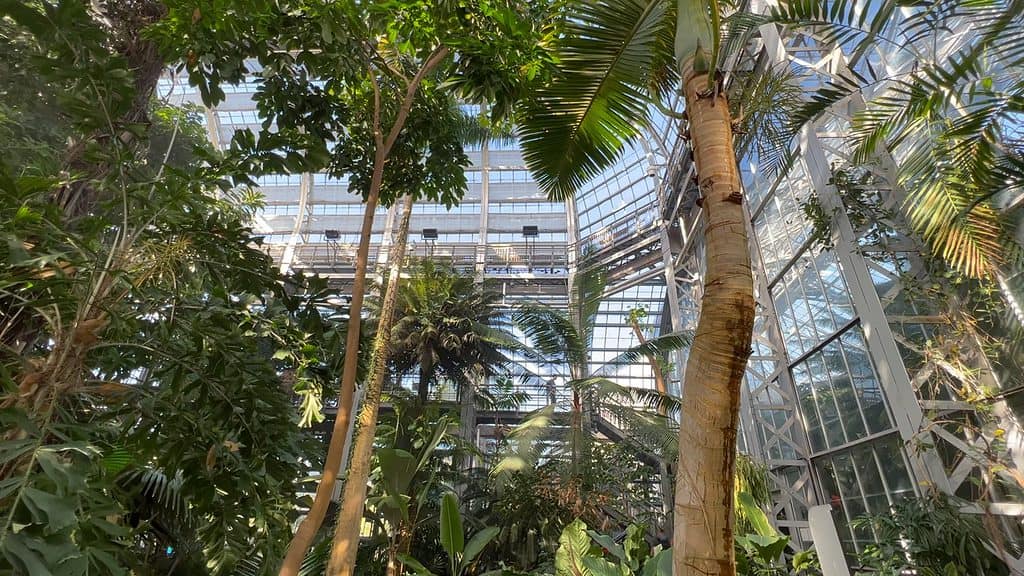
Washington D.C. The United States Botanic Garden is the oldest continuously operating botanic garden in the United States, established by Congress in 1820 and open to the public since 1850.
The historic Lord & Burnham greenhouse has two courtyards and ten incredible gardens under its roof, for a total of 28,944 square feet of exhibition space.
We’ll see them all, including the outdoor gardens and the grand Bartholdi Fountain.
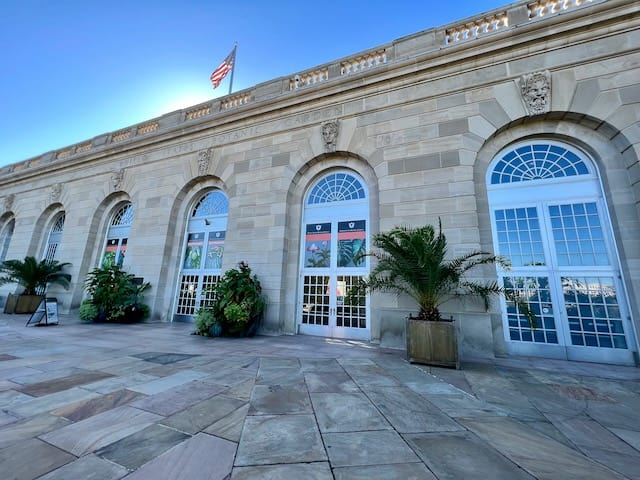
Whether you are planning a trip to the United States Botanical Garden or are just interested in seeing it from afar, this post will take you on a journey through its treasury of plants. A US Botanical Garden Travel Guide is located at the end of the post to assist you in planning your trip.
United States Botanic Garden Conservatory
The garden’s main Conservatory is a large, Victorian-style glass house built in 1933. It features over 4,000 species of plants.
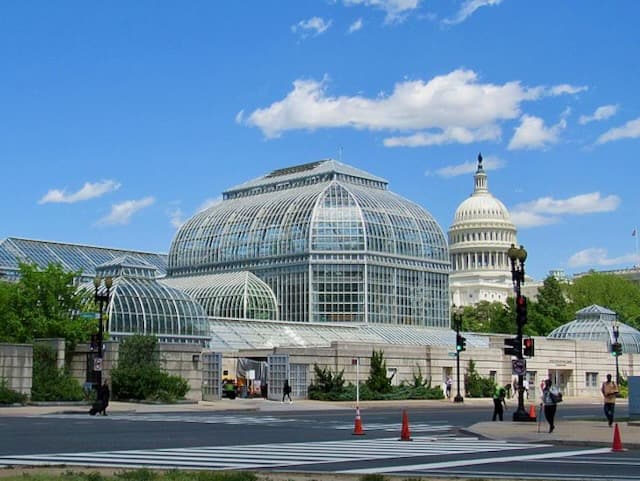
The Conservatory is divided into themed areas, each with unique plant displays.
1. Garden Court
The Garden Court is the entryway of the US Botanic Garden. The visitor is greeted with colorful foliage, flowers, and water features to create a beautiful backdrop presenting the story of plants that support, nourish, and protect.
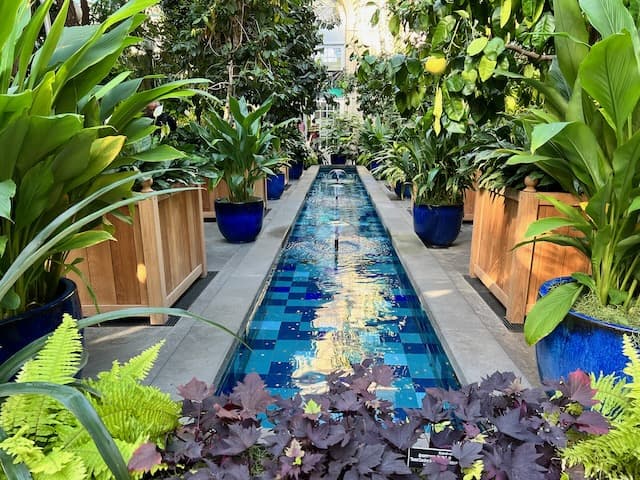
The US Botanic Garden has a school field trip vibe: The signage around the plants is complete and well-placed, the volunteers are very helpful and generous with their knowledge, and the displays are so intriguing that you can’t help but learn.
United States Botanic Garden Mission
The U.S. Botanic Garden inspires people to appreciate, study, and conserve plants to enrich society locally and globally.
United States Botanic Garden Website
The Garden was a vision of George Washington, Thomas Jefferson, and James Madison, who thought the capital city should have a botanic garden to demonstrate the importance of plants to the nation.
2. The Tropical Rainforest
This area features plants from tropical rainforests worldwide, including ferns, palms, and bromeliads. It is designed to mimic a tropical rainforest’s humid, warm environment and includes a small pond and waterfall.
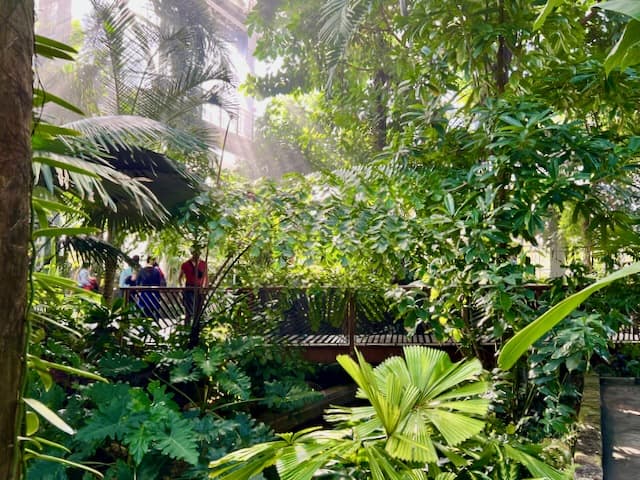
The conservatory dome rises to 93 feet with a walkway that allows visitors to view the forest canopy from up high.
3. The Desert Garden
The displays in the Desert Garden show how cacti, succulents, and other plants are adapted to dry environments in various ways.
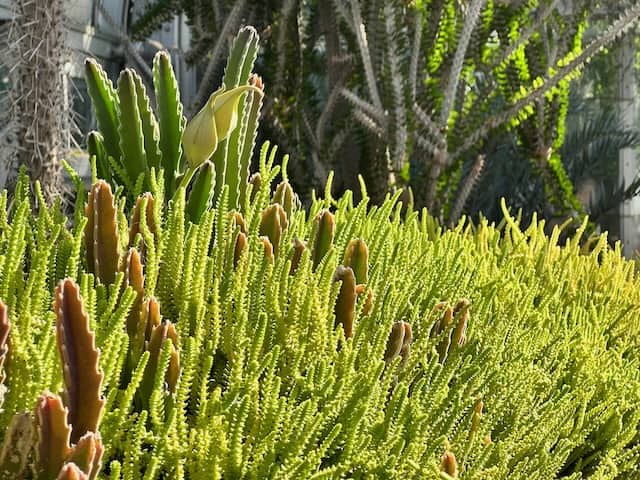
4. Native Hawaiian Plants
This collection features plants native to the Hawaiian Islands. Due to geographic isolation, the evolution of Hawaiian flora is unique and, unfortunately one of the most threatened in the world.

5. Children’s Garden Courtyard
The Children’s garden is a place to explore nature through play and sensory experiences. Children are encouraged to water the garden plants, climb a tree house, and dig in the dirt.
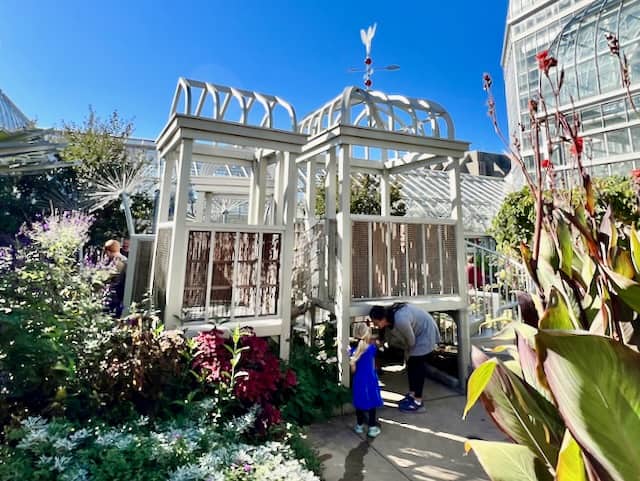
6. Primeval Garden
This garden is a glimpse of the world 150 million years ago before flowering plants dominated the landscape.
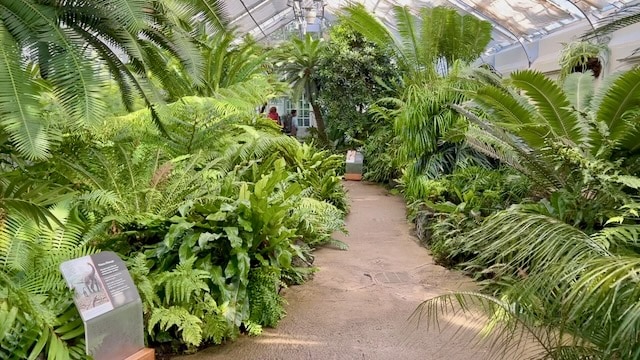
7. Carnivorous plants (Plant Adaptations)
Some plants aren’t eaten by bugs. They eat the bugs! There are about 700 species of carnivorous plants throughout the world.
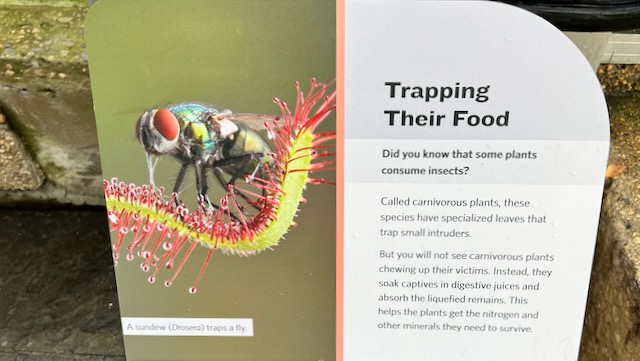
Carnivorous plants have evolved to live in various ecosystems where the soil may be poor. The plants show fascinating adaptations.
8. Rare and Endangered (Plant Conservation)
The Garden collection of rare and endangered plants is used for study, exhibition, and exchange with other institutions.
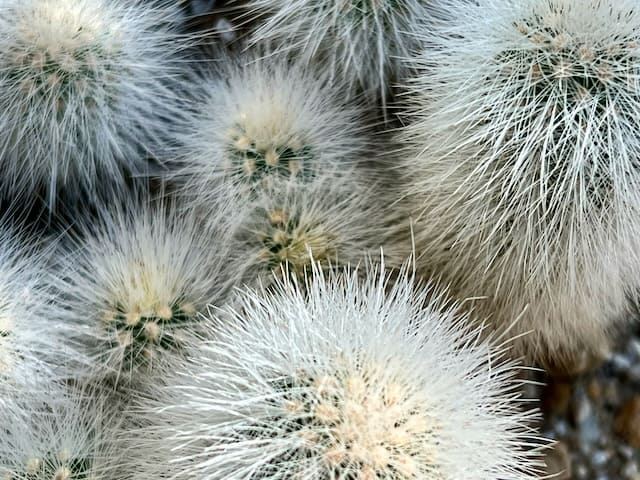
9. The Mediterranean Garden
Featured plants include Mediterranean natives, olive trees, fig trees, and lavender. The garden is designed to resemble a traditional Mediterranean courtyard, with a fountain and stone walkways.
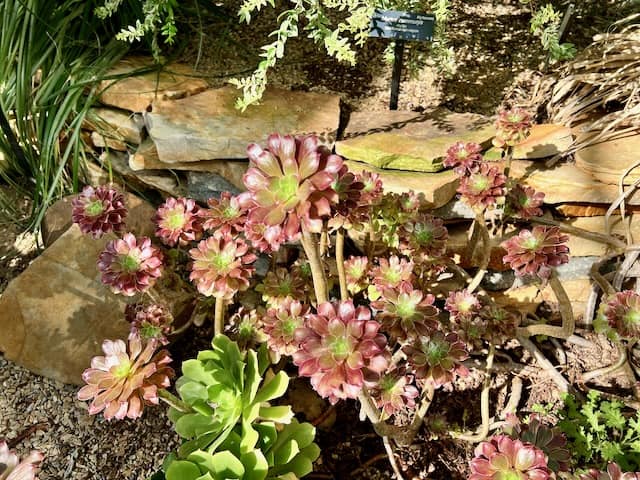
10. The Orchid Collection
The orchid display is one of the United States Botanic Garden’s most celebrated exhibits dating back to the 1800s. This display showcases 100’s blooming orchids that change frequently. The orchid collection numbers about 3,000 specimens.

During the winter, the U.S. Botanic Garden celebrates the diversity of orchids from around the world. Throughout the Conservatory, thousands of orchid blooms showcase the United States Botanic Garden and Smithsonian Gardens’ extensive orchid collections.
11. The Medicinal Plant Garden
See medicinal plants from around the world. Plants have been used in medicinal remedies for thousands of years, and scientists continue to build upon knowledge of plant-based compounds in modern medicine.
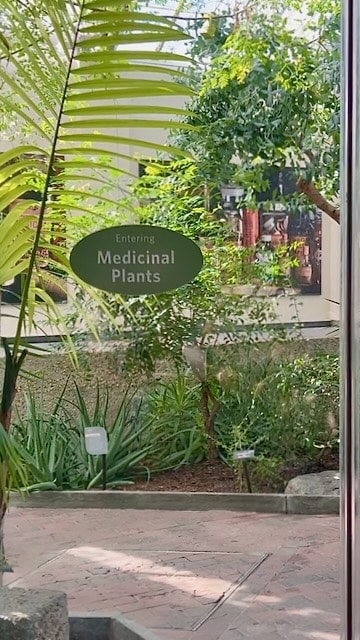
12. Southern Exposure Garden
Growing conditions influenced by heat-trapping topography, buildings, and concrete create microclimates. The Southern Exposure Garden shows gardeners how to grow plants generally found in climates further south. The garden is open from spring to fall.
13. East and West Gallery
Off to the sides of the Garden Courtyard are two galleries. Exhibits change regularly and are designed to educate and inspire visitors. You’ll also find gift shops in the galleries.
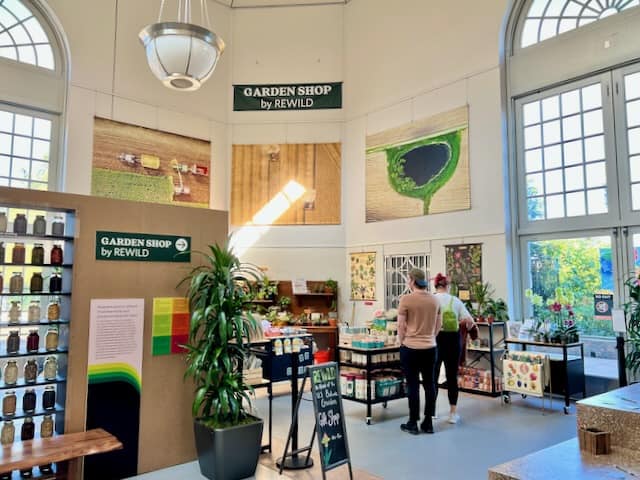
U.S. Botanic Garden Plant Collection
More than a million visitors explore the gardens yearly. The gardens contain historical specimens, some dating back to an 1842 U.S. Exploring Expedition.
The Garden’s noteworthy collections include:
- economic plants
- medicinal plants
- orchids
- carnivorous plants
- cacti and other succulents
- aroids
- plants of eastern North America,
- bromeliads
- cycads
- ferns
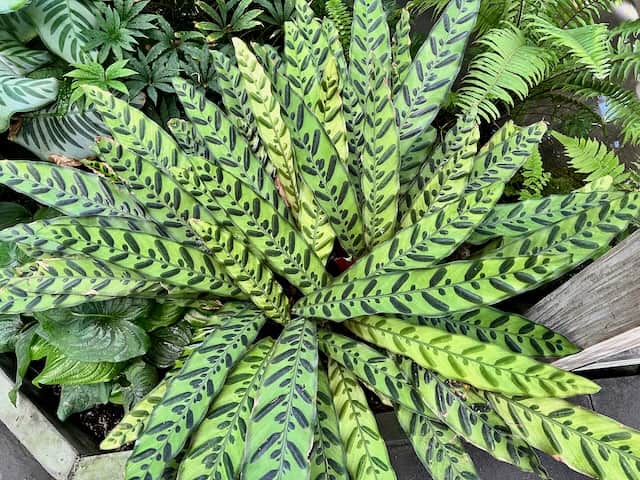
Some historic specimens date back to the original collection of 1842. The US Botanic Garden maintains a database that is accessible online to all. See More Resources for the US Botanic Garden section.
Outdoor US Botanic Gardens
The United States Botanic Garden has several outdoor gardens within a three-acre gated urban oasis. The gardens are designed to showcase the beauty and diversity of plants from around the world.
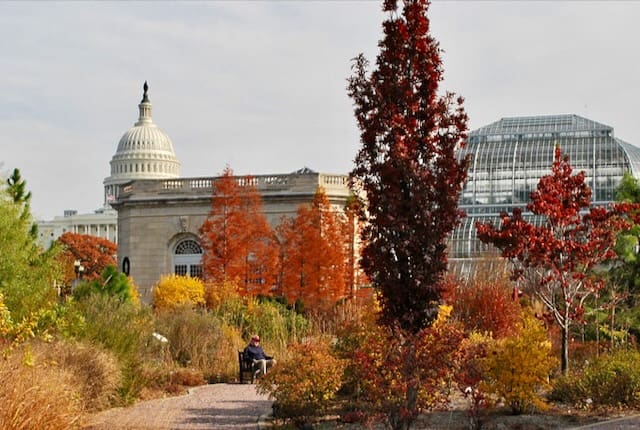
The gardens offer both formal and naturalistic areas. Visitors see examples of how plants can provide wildlife habitat while beautifying outdoor spaces.
The outdoor gardens at the United States Botanic Garden include the following:
Regional Garden
The Regional Garden features Mid-Atlantic native plants selected to highlight the region’s beauty.
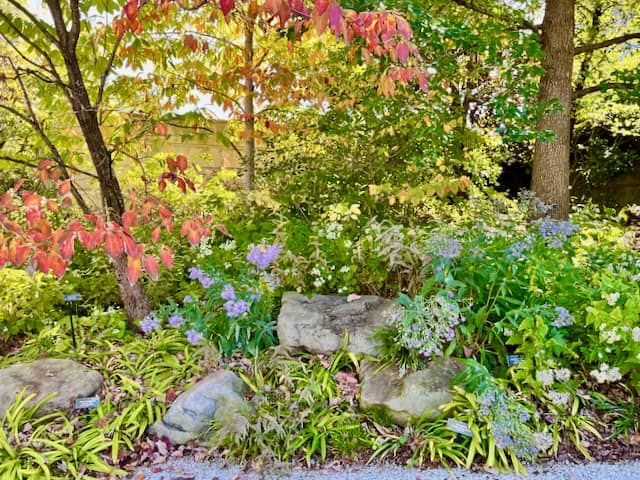
The Rose Garden
This garden features a variety of roses. Formal in design with rows of roses separated by paths, the garden peaks in the summer when the roses bloom.
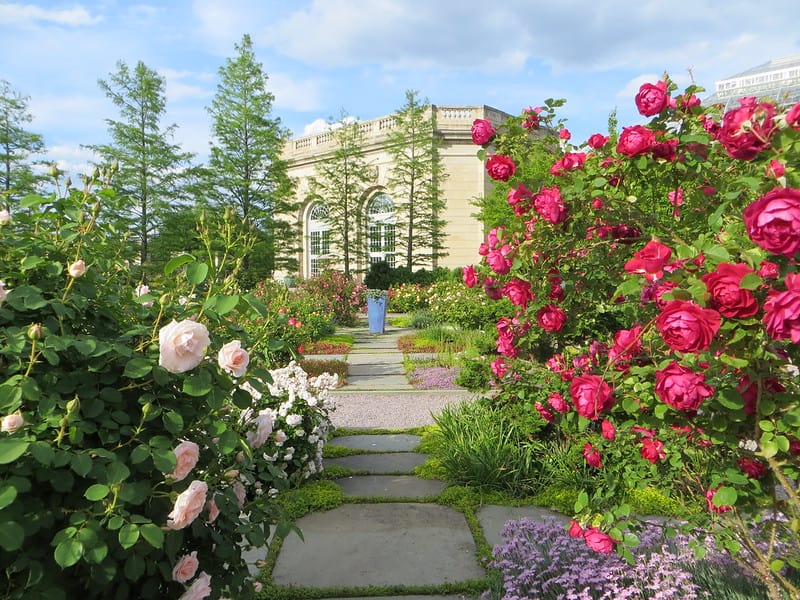
The Pollinator Garden:
This garden is home to various butterflies and other pollinators and features plants attractive to butterflies.

First Ladies Water Garden
The garden is named in honor of the First Ladies of the United States and was designed to showcase the beauty and diversity of water-loving plants. Unfortunately, the water was off, and the fountain was dry when I visited.
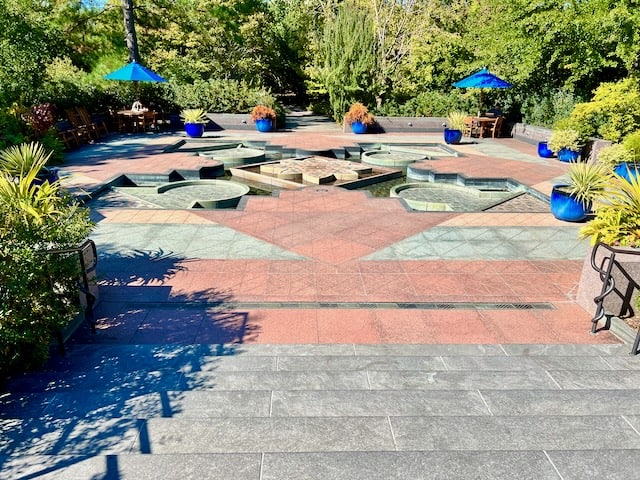
Amphitheater
The Amphitheater is an outdoor gathering place used for a variety of events. Salvaged marble steps from the front of the U.S. Capitol were used to create the structure. The Amphitheater provides a spot to relax and enjoy the beauty of nature while taking a break from the city.
The Bartholdi Fountain and Gardens
Directly across Independence Avenue from the U.S. Botanic Garden Conservatory is the Bartholdi Fountain and Gardens. The Fountain of Light and Water (the Bartholdi Fountain) dominates the space.
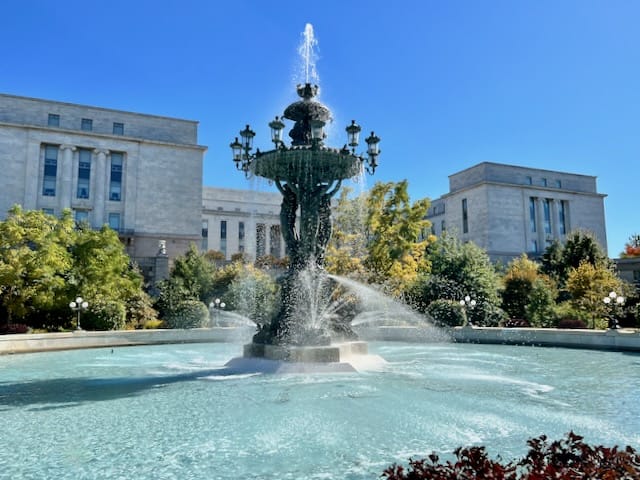
The cast-iron fountain weighs more than 15 tons and stands 30 feet tall. It is an elegant expression of the Gilded Age and is on the list of historically significant American and international landmarks.
Frédéric Auguste Bartholdi (1834-1904) was a French sculptor famous for creating the Statue of Liberty. He made this fountain for the 1876 Centennial Exposition in Philadelphia. It is glorious during the day, but after sunset, it’s magical when the lights cast their glow.
Side note: Bartholdi’s bronze model he used for creating the Statue of Liberty stands in the Luxembourg Gardens in Paris, France.
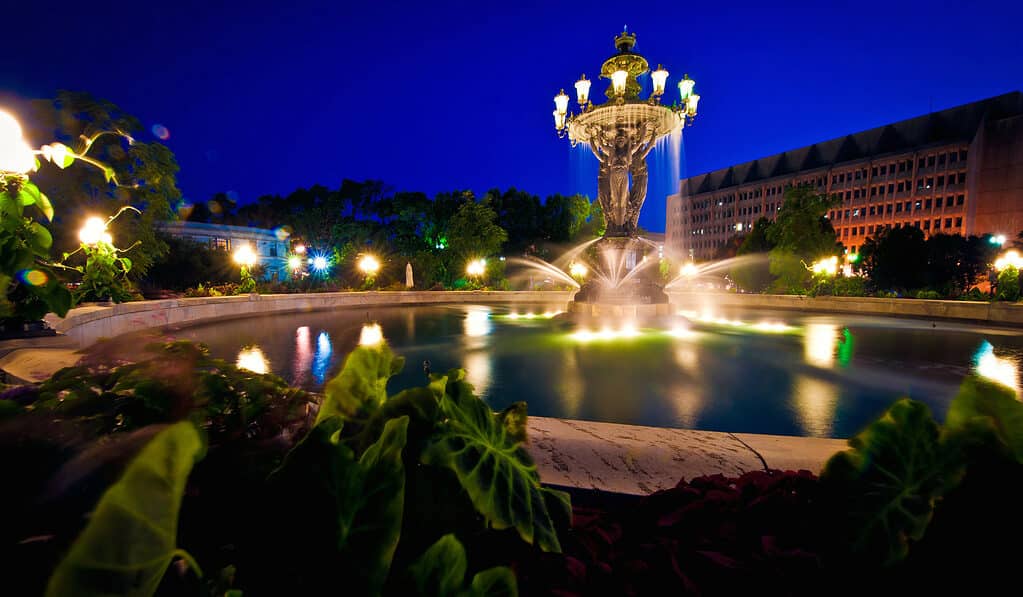
The Bartholdi Gardens is a two-acre garden showcasing plant combinations of various styles and designs.
Redesigned in 2016 as a Sustainable SITES Initiative (SITES) pilot project, a study of each demonstration area design is intended to help the home gardener improve their garden design and maintenance practices nationwide.
Production House
The U.S. Botanic Garden maintains a Production Facility in Southwest Washington, D.C. It is the largest greenhouse complex supporting a public garden in the United States.
Usually closed to the public, the Production Facility hosts an open house each spring. Visitors have a unique opportunity to explore this wonderland of plants. Look for it around the first week of March.
The current greenhouse has 85,000 square feet under glass and is divided into 34 greenhouse bays and 17 environmental zones. Computerized ecological controls provide the ability to grow a wide variety of plants.
The United States Botanic Garden Then and Now
The United States Botanic Garden was established by the federal government to promote the study and conservation of plants while providing information about the role of plants in our lives to the public.
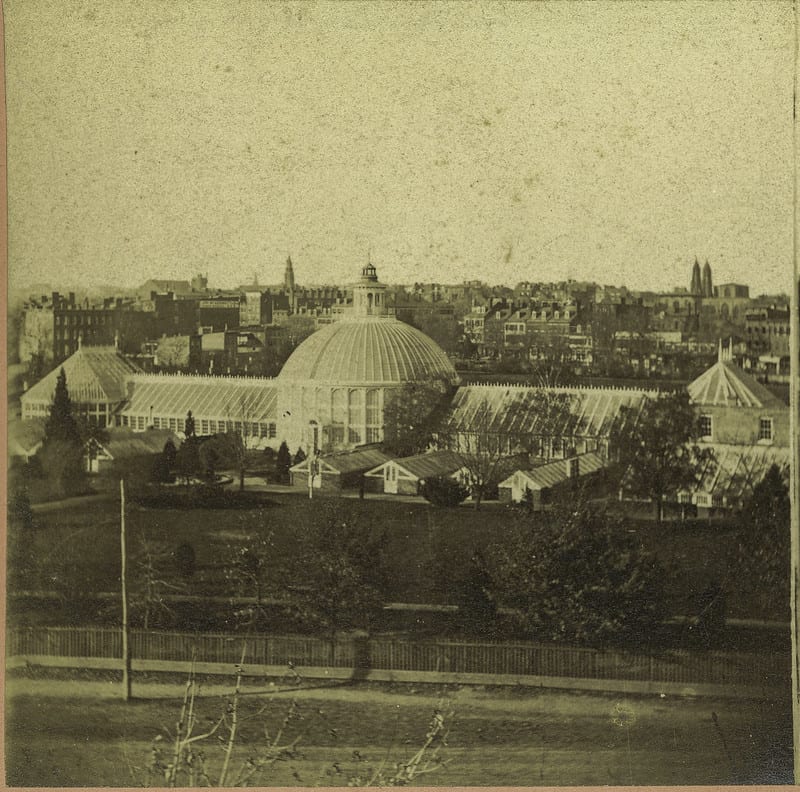
The garden has a long and storied history and has played a significant role in the development of botanical science in the United States. The United States Botanic Garden’s first location was a small plot of land near the Capitol Building, where it grew medicinal plants for use by the military and Congress.
In the 1870s, the garden was moved to its current location on the National Mall. A large Victorian-style glass house was built for the garden’s growing collection of plants.
Today the U.S. Botanic Garden is home to a collection of plants from around the world, including rare and endangered species. The garden is a popular destination for tourists and locals alike.

Visitors Guide to United States Botanic Garden, Washington D.C.
Address: 100 Maryland Ave. SW, Washington, DC 20001. The Conservatory is located on Capitol Hill. The outdoor gardens are adjacent to the Conservatory, and the Bartholdi Fountain and Gardens are located across Independence Avenue from the Conservatory.
How to Best Experience the United States Botanic Garden
If you are looking for a quieter time to visit, January to early March and mid-July to early September tend to be the least crowded, according to the US Botanical Garden Website. Early and late afternoon times also tend to be less busy.
Enter the United State Botanic Garden from Maryland Ave. This puts you directly in front of the entrance. Note the architecture of the facade. It was inspired by the Palace of Versailles’ Orangerie.
Entering the Garden Court, pick up your map and head into the Tropical Conservatory. The layout of the US Botanic Garden will take you through half the route on either the east or west. Either way, you’ll end up back in the Garden Court, then cross the garden court to the opposite side and do the other half.
After exploring the Conservatory, go out the front door, and turn left (west) to the Outdoor Gardens. The path will take you through the pollinator garden (note the beautifully planted pots), First Ladies Water Garden, Regional Garden, Amphitheater, and the Rose Garden.
From the Outdoor Garden lawn area, turn right (south) and cross Independence Ave to the Bartholdi Fountain and Gardens. The fountain is spectacular when lit up at night.
Afterward, cross over Independence Ave to the Conservatory and walk around the United States Botanic Garden Conservatory building. There are exciting plantings on every side to explore.
Map of the United States Botanic Garden
United States Botanic Garden Conservatory

United States Botanic Garden Outdoor Gardens
See US Botanic Exterior Gardens surrounding the conservatory.
US Botanic Garden Hours
The United States Botanic Garden Conservatory is open daily from 10:00 am to 5:00 pm.
The gated outdoor gardens are open daily from 7:30 am to 5:00 pm. Extended evening hours until 7:00 pm are offered from April 1 – September 15.
Bartholdi Fountain and Gardens are open from dawn to dusk daily, including weekends and holidays.
United States Botanic Garden Tickets
Admission is FREE. Tickets are not required.
United States Botanic Garden Parking
The Garden does not have dedicated parking. The easiest way to reach the Garden is by Metrorail. The Conservatory entrance is on Maryland Avenue.
Metrobuses #32, 34, and 36 stop behind the Conservatory at Independence Avenue and First Street SW.
The National Mall route of the DC Circulator bus stops near the Conservatory by the Capitol Reflecting Pool.
Metered street parking spaces may be available within a few blocks of the US Botanic Garden. There are several commercial parking facilities nearby, and you can book guaranteed parking in nearby garages in advance with ParkWhiz.
Accessibility United States Botanic Garden
The US Botanic Garden has one of the most extensive accessibility programs. Items include wheelchairs, sensory items, colorblind glasses, permitted mobility devices, sensory-friendly quarterly early openings, online transcription programs, assisted listening devices, and sign language interpretation. See the Accessibility section of the US Botanic Garden website for details.
Pet Policy U.S. Botanic Garden
Service dogs trained to work or perform tasks for an individual with a disability are welcome in all areas of the Garden unless the dog poses a direct threat, is not housebroken, or is not under their control. Leashed pets are allowed in the outdoor gardens.
Photography Policy U.S. Botanic Garden
Visitors are encouraged to take casual photographs for their own personal use.
Photos must be taken with hand-held cameras or cameras on a permitted tripod, and external flash equipment or bulky accessory equipment is not permitted.
Visitors are not allowed to do photoshoots or video shoots in the Garden. Commercial use of all photographs is prohibited.
Restaurants Near U.S. Botanic Garden
Unfortunately, there isn’t a cafe at the United States Botanic Garden. Grabbing a light lunch at a nearby Smithsonian Museum cafe surrounded by art is a unique experience.
Mitsitam Cafe
Walk next door to the National Museum of the American Indian cafe, Mitsitam. Check out the surrounding Smithsonian Gardens Native Landscape the head indoors to enjoy the indigenous cuisines of the Americas. Five food stations—Contemporary Native; Mountains and Plains; Native Comfort; Oceans, Sea, and Streams. Cafeteria style. Entrance to the museum is free.
4th Street and Independence Ave. SW, Washington DC, 20560. 0.3 miles (about a 5-minute walk) Inside the National Museum of the American Indian. 11 am – 4 pm, 7 days a week.
Garden Cafe. A lovely spot inside the National Gallery of Art. Dine by a fountain. The menu features Sandwiches, soup, salads, pastries, and desserts. Vegetarian-friendly serving Lunch, Brunch.
6th St. & Constitution Ave. NW National Gallery of Art, West Building, Washington DC, 20004. 0.6 miles (about an 11-minute walk). The café is located near the 6th Street entrance to the West Building. 10:00 am–4:30 pm.
Cascade Café. The Cascade Café, located on the Concourse between the East and West Buildings, serves an ever-changing selection of fresh pizzas, grill items, salads, and grab-and-go offerings in a food-court environment.
4th and Constitution Avenue NW East Building, Concourse Level, Washington DC, 20565. 0.5 miles (about an 11-minute walk) 11:00 am –3:00 pm.
Where to Stay in Washington D.C.
Holiday Inn
Popular in this area is the Holiday Inn Washington Capitol. Bonus: It is pet friendly.
550 C St SW, Washington DC, DC 20024-2572 0.5 miles (10-minute walk).
A little further in the Penn Quarter, these hotels are centrally located and still within a moderate walk to the United States Botanic Garden:
Kimpton Hotel Monaco Washington DC
A Conde Nast Readers Choice Award winner in 2021. Centrally located Penn Quarter hotel — a beautiful juxtaposition between old and new elegance-meets-whimsy style.
700 F St NW, Washington, DC 20004 0.9 Miles (about a 20-minute walk).
Riggs Washington DC
Recognized as the Best Hotel in Washington, D.C. in the World in the Travel + Leisure 2022 World’s Best Awards. Located in the historic former Riggs National Bank building, details throughout the hotel draw on a narrative inspired by the golden age of banking.
900 F St NW, Washington, DC 20004. 1.1 Mile (about a 23 Minute walk).
Motto by Hilton Washington DC
Uniquely urban hotel featuring smart tech with a smaller, more efficient footprint in Travel-Sized rooms. Across the street from Gallery Place/Chinatown Metro station with links to Reagan National Airport.
627 H St NW, Washington, DC 20001. 1.2 Miles (about a 24-minute walk).
Author’s Note: The recommendations are not sponsored; they are my personal experience or researched suggestions.
Other Gardens Near the United State Botanic Garden
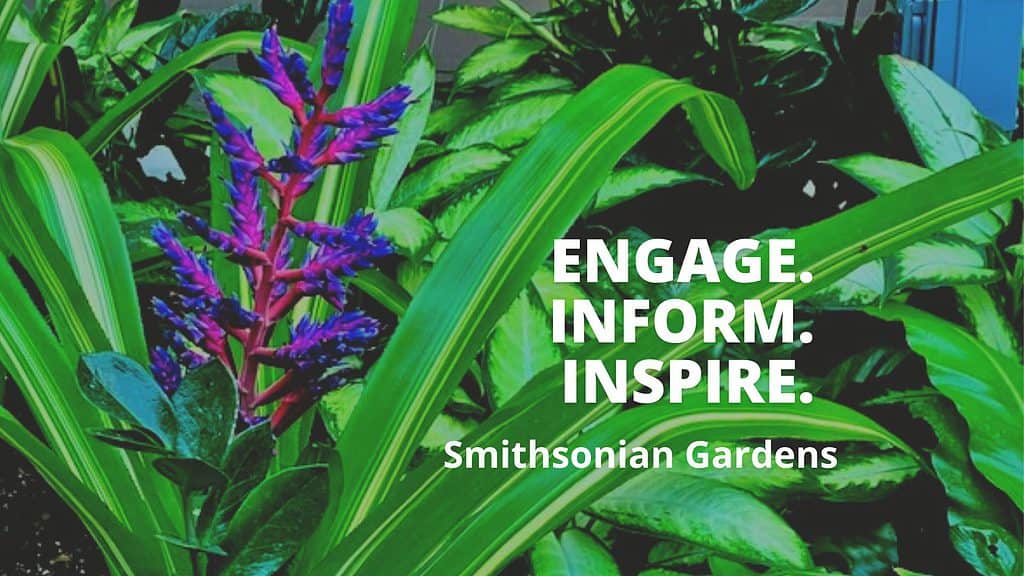
There are 13 Smithsonian Gardens near or on the National Mall. See 13 Smithsonian Gardens You Can Enjoy for Free for a complete list of locations.
The closest Smithsonian Garden is the Native Landscape at the National Museum of the American Indian. Or cross the National Mall to the north side and see the Pollinator Garden. The Kogod Courtyard is slightly north, but it is architecturally stunning.
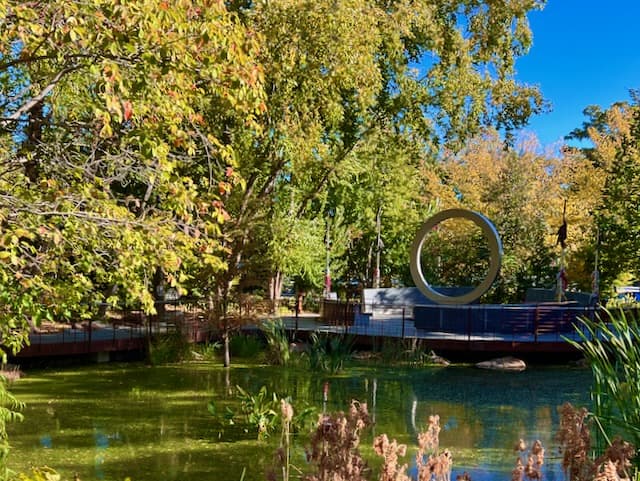
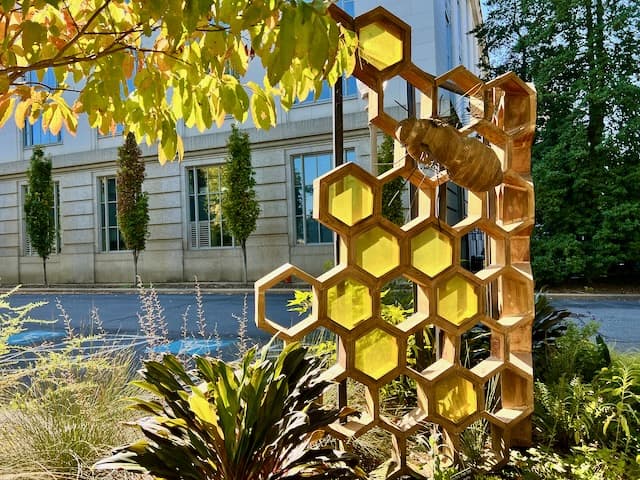
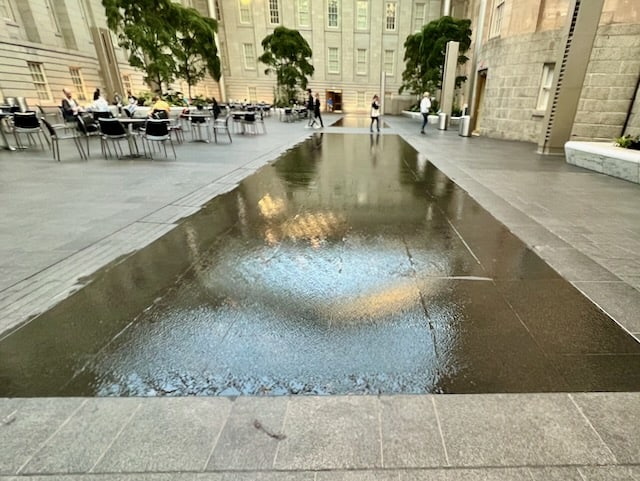
More Resources for US Botanic Garden
Visit the United States Botanic Garden website.
An excellent, comprehensive book about the history and plants of the US Botanic Garden is available as a free PDF download A Botanic Garden for the Nation by Anne Catherine Fallen. Beautiful photos fill the book. Or, you can buy a printed copy on Amazon.
Visitor Guides The Garden’s Map and Visitor Guide is available in nine languages, Braille, large print, and may be picked up in the Conservatory lobby or downloaded as a PDF.
Search the United States Botanic Garden’s noteworthy plant collections, including some that date back to the 1842 originals.
Download a free PDF copy of History of the United States Botanic Garden 1816-1991. This book details the background, founding, and history of the US Botanic Garden through more than 150 years. Researched and written by Karen Solit.
United States Botanic Garden Photos The United States Botanic garden celebrated the 200th anniversary of its 1820 charter. It released this album sharing a collection of Garden photos through the last two centuries.
Recent Posts
Museums for All in Botanical Gardens and Arboretums Blooming with Access
Museums for All is an initiative that allows individuals and families receiving food assistance (SNAP EBT - Supplemental Nutrition Assistance Program Electronic Benefit Transfer) to gain free or...
San Diego Botanic Garden, Encinitas, CA: The San Diego Botanic Garden in Encinitas is a 37-acre sanctuary about a 30-minute drive north of the city of San Diego. Just a mile from the Pacific...
